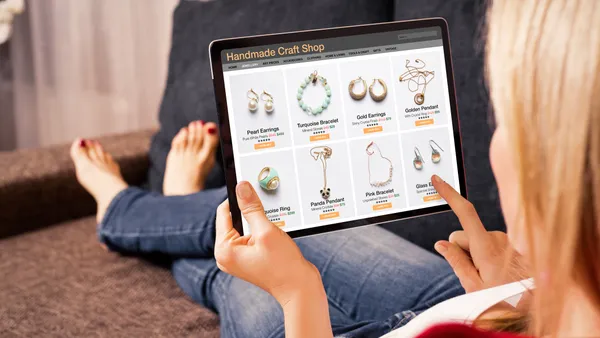Dive Brief:
-
Mobile commerce conducted through smartphones will account for $117 billion in the U.S. alone this year, translating to about 23% of online retail sales and 3% of all retail sales, according to a new report from research firm Forrester e-mailed to Retail Dive.
-
However, after a 41% increase in direct sales through smartphones from 2016 to 2017, mobile commerce growth between now and 2022 will be more subdued, occurring at a compound annual growth rate of 16%, Forrester said.
-
Despite slowing growth in sales via smartphone in the years to come, these devices will still influence about $1.3 trillion of U.S. retail sales this year, after influencing more than $1.2 trillion in sales in 2017, according to the report.
Dive Insight:
Forrester has suggested in past mobile commerce studies that the rate of growth in purchases made via mobile is due to taper off, so the slowing growth rate quoted in this report is consistent with past numbers. It is important to note that the mobile commerce arrow is still pointing way up, with those sales made directly through smartphones expected to hit $209 billion by 2022. The market is still big and growing, and somewhat slower growth isn't likely to make any retailers put off their mobile commerce investments.
More significantly, the role of smartphones during the shopping process is much bigger and broader than the impact of those sales alone. As Forrester analysts said in the report, "By researching products, comparing prices and making payments, shoppers have made smartphones an integral part of their customer journey."
Knowing this, retailers may feel they can hedge a bit on investing in their mobile websites and instead plow more money into mobile promotions and payments, but that would be a mistake. In fact, it may be a mistake already being made, as Forrester, reiterating observations it has made in previous studies, said that poor performance and lack of mobile-optimized experiences on retailer websites are frustrating shoppers enough that they may see no reason to buy through mobile more than they already do.
That's not the only issue burdening the future growth of mobile commerce, however. Shoppers also tend to choose the largest screen possible for a more comfortable experience when they shop online, meaning they may put down the phone with the five-inch screen and pick up the laptop with the 15-inch screen when they can.
In fact, Forrester surveyed more than a thousand U.S. online adults "who use smartphones and buy products and services online but have not done so on a smartphone in the past three months," and found that 51% of them believe it's just easier to make purchases on a laptop than on a smartphone. Retailers may not be able to change anything about the comfort level shoppers have with larger screens, but they can improve the mobile shopping experience, and make efforts to understand how mobile is more broadly influencing sales.












